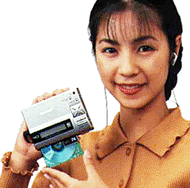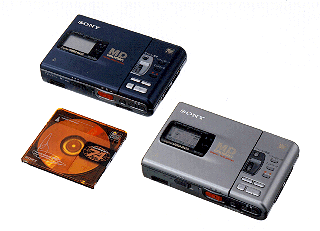Test of the portable MiniDisc recorders from Sharp and
Sony
One for Everything?
German Stereo Magazine 8/97
Someone who wants to switch from compact cassette to
MiniDisc needs 3 new units: a recorder at home, a player for the car,
and a porti player to replace his walkman. All three together cost at
best nearly 2000DM. If you choose a porti recorder instead
you can cover all three needs with one unit - for only 600 DM. BUT:
Does a porti recorder achieve the quality of a home deck?
The MiniDisc is the ideal media for portable use: small, robust, and
enclosed in a dust protecting cartridge. In this respect the MD is ahead
of the CD and is recordable as well. It's a small wonder that you can
build complex data reduction electronics, A/D and D/A converters, and
control chips into a case of the size of a walkman. But does the
compact method of construction force the developers to compromise?
The Sony has the flattest case: The MD is slid into the guide slot
of the opened lid and is placed directly onto the drive shaft when you
close the lid. This principle was taken from the cassette Walkmans and
allows the lowest case height. The Sharp porti uses a slot-in
mechanism like the ones we know in home decks - this method requires more
height to lower the MD onto the drive shaft. The slot-in mechanism is
more practical and robust, but it makes the Sharp look more bulky.
The width is determined by the width of an MD and the rechargeable cell
that is placed beside it. Sharp and Sony have chosen a special lithium
cell that is charged with the supplied power adapter and
doesn't suffer from memory effects. You can also connect a supplied
battery case for two drycells to the Sony portable.
Comparing features, the tiny MDs don't have to hide behind
the home decks any more. They even have a microphone input and an
optical digital input which can handle all three common sample rates.
However, you need a special optical adapter-cable [TOS-link
<-> optical miniplug? -eaw] that is unfortunately not
supplied. Neither recorder has a digital output. When you record from
the analog input you can adjust the recording level manually - with the
Sony you also have the option of automatic gain control. The nine
segment recording level meter is reasonable, but the Sony
doesn't have an overload tag. However the MZ-R30 has a
spacious display with a position indicator and simultaneous display of
time and title information.
If you record digitally from a CD the track marks are copied
correctly, but not the CD-text. Even if you copy from MD to MD the
title and track information is lost - the music industry doesn't
allow it. But Sharp has thought of a trick: After copying the music
data, whoever wants to copy the text of the original MD must put the
original disc into the recorder, this reads the information and stores
it. Then the daughter disc is put into the recorder and the stored
text is written onto it.
Both portis also have a memory for audio data: Its purpose is to
maintain the data stream when the laser loses disc tracking due to
heavy shocks. The Sharp stores 10, or in power save mode, 5 seconds of
music. Both portis master even continuous vibrations astonishingly
well, without perceptable dropouts. Only with regular jarring, which
you get when you jog, do they give up after some time. Even if you are
recording there is no "blur" as long as you don't overdo it with
movements - important when you make interviews with your portable in
your hand. The porties are suitable for journalists, especially the
Sony with its automatic control of the recording level. But microphone
recordings from both units aren't particularly noise free.
If you record from CD and play back over a Hi-Fi system, both tiny
MDs achieve excellent sound quality - the Sharp recorder sounding better
than the Sony. The Sharp already uses Sharp's ATRAC version 5.0
[This is in error, the MS200 is known to be Sharp ATRAC 4.0. -eaw]
which transmits frequencies up to 20 kHz, the Sony uses the Sony ATRAC
4.0 chip. The Sharp also has an advantage over the Sony concerning
noise and the clear playback of small music levels. It can nearly
match the full-size MDS-JE500 deck. The fact that the Sharp
can't reach the converter quality level of the full-size decks
has its cause in the lower supply voltage and cheaper voltage
stabilization. Nevertheless: an excellent result for a porti.
|
Sharp MD-MS 200
DM 600
An adequate MD recorder with a solid case that does its job at home
and on the road. Its sound quality nearly reaches the sound
quality of similarly priced full sized decks and it handles up to 20
kHz. It's only a pity that it has no digital output. |
Sony MZ-R 30
DM 600
Thanks to ATRAC 4.0 now with a sampling rate converter. Good sound
quality in recordings from CD - the converters don't reach the
quality of the MDS-JE500 which has the same price. Very practical:
automatic control of record level for microphone recordings. Dropouts
from vibrations only in hard jogging. |
| Excellent: * * * |
Very good: * * |
 |
 |
Lab Report
| Parameter | Sharp
MD-MS200 | Sony
MZ-R30 | Min.
acceptable
value | Excellent
value |
| Sound Quality |
Frequency characteristics of the data reduction system:
Using multi-tone signals, upper cutoff frequency |
20 khz |
18 khz | | |
| Recording over digital input (D/A converter) | | | | |
| Frequency characteristics | | | | |
| Maximum gain drift without pre-emphasis | 0.5dB | 1.2dB | 1dB | 0.2dB |
| Maximum gain drift with pre-emphasis | 0.4dB | 1.0dB | 1dB | 0.2dB |
| Square wave behavior | Very Good | Very Good | | |
| Distortion factor 400Hz at -60dB | 0.3% | 0.4% | 5% | 0.2% |
| Alias distortion at -30dB | <0.03% | <0.03% | 1% | 0.03% |
| Converter linearity, maximum drift | 0.9dB | 0.3dB | 5dB | 0.5dB |
| Converter monotonicity | Poor | Bad | | |
| Noise floor ``digital null'' | 90.5dBA | 86dBA | 88dBA | 106dBA |
| Quantization noise floor at 400Hz / 0dB | 89dB | 82.5dB | 77dB | 95dB |
| Recording over analog input (A/D converter) | | | | |
| Frequency characteristics | | | | |
| Maximum gain drift | 0.6dB | 1.9dB | 1dB | 0.2dB |
| Square wave behavior | Very Good | Poor | | |
| Distortion factor 400Hz at -60dB | 0.5% | 0.6% | 5% | 0.2% |
| Alias distortion at -30dB | <0.15% | <0.06% | 1% | 0.03% |
| Noise floor | 90.5dBA | 84.5dBA | 86dBA | 95dBA |
| Quantization noise floor | 89dB | 82.5dB | 77dB | 95dB |
| Practical Issues |
| Input/Output Values | | | | |
| Line | | | | |
| Input sensitivity | 410mV | 180mV | 500mV | 200mV |
| Input impedance | 14kOhm | 55kOhm | 10kOhm | 50kOhm |
| Output voltage left/right at 0dB | 1.47V / 1.48V | 0.76V / 0.76V | | |
| Maximum channel drift | 0.13dB | 0.2dB | 0dB |
| Output impedance at 20kHz | 0.02kOhm | 0.44kOhm | 3.0kOhm | 0.2kOhm |
| Microphone | | | | |
| Input sensitivity | 0.6mV | 0.1mV | 2.5mV | 0.5mV |
| Input impedance | 5.0kOhm | 5.0kOhm | 1kOhm | 10kOhm |
| Resistance to Overmodulation | 49dB | 55dB | 20dB | 40dB |
| Noise Floor | 65dB | 65dB | 65dB | 80dB |

